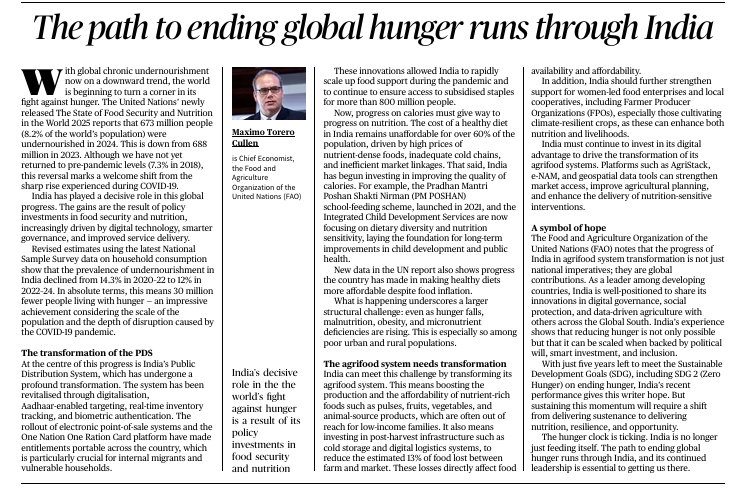Key Points from the Article:
- Proposed GST Reform:
- The central government is proposing reforms to the Goods and Services Tax (GST) system to help boost consumption, especially in the middle class and business sectors.
- The primary aim is to reduce the tax burden on consumers and increase consumption.
- GST Rate Restructuring:
- The government is considering reducing the GST rate from 12% and 18% to a lower 5% rate for many items. Around 90% of items in the 12% and 18% brackets are expected to benefit from this reduction.
- This restructuring is intended to simplify the GST system and reduce ambiguities.
- Simplifying GST:
- The focus is not only on reducing rates but also on simplifying the entire GST process.
- Proposals include easier registration, streamlined tax payment procedures, and faster refunds, which will make it easier for taxpayers to comply with the system.
- Reducing Complexity:
- A major issue in the current GST setup is the complexity arising from multiple tax rates. The government aims to make the system simpler for businesses and consumers alike.
- The rate restructuring is also expected to reduce litigation and disputes arising from the current rate framework.
- Predicted Revenue Impact:
- The government has not disclosed the exact revenue loss from the proposed changes, but the expectation is that the reduction in tax rates will still help boost overall consumption, and the increased consumption will offset the loss of revenue.
- Economic Growth Focus:
- The proposal comes at a time when India’s economy faces challenges due to a slowing export demand and economic uncertainties.
- The government is confident that the increase in domestic consumption, coupled with the expected easing of the tax structure, will help sustain growth and prevent a sharp revenue decline.
- Increased Revenue via Consumption:
- With a significant reduction in taxes and a widened tax base, the government believes that higher consumption will increase overall revenue from GST despite lower tax rates.
- Public and Business Reactions:
- The government has been in discussions with businesses, and there is a general optimism that simplifying the system will help businesses while benefiting consumers.
- However, there is some resistance from specific sectors, especially related to the petroleum industry, where further tax adjustments are seen as unlikely.
Conclusion:
The government’s proposal aims at striking a balance between lowering the tax burden on consumers and businesses while boosting overall consumption to offset the potential revenue loss. The simplification of the GST structure is expected to reduce complexities, enhance compliance, and foster economic growth despite the uncertainties surrounding the global economy.
Introduction
- The editorial discusses the global progress in reducing hunger and highlights India’s crucial role in achieving these outcomes, particularly through its food security systems, technological innovations, and governance reforms.
Key Points
- Global Hunger Trend
- Data Point: Global hunger is on a downward trajectory. The number of undernourished people has decreased from 688 million in 2022 to 673 million in 2024 (8.2% of the world’s population).
- Context: This marks a positive shift following disruptions caused by the COVID-19 pandemic.
- India’s Role in Hunger Reduction
- Data Point: India’s hunger prevalence has decreased significantly, with the undernourishment rate dropping from 14.3% (2020-22) to 12% (2022-24).
- Significance: India has made substantial progress, contributing to the global decline in hunger.
- Public Distribution System (PDS) and Technological Advancements
- PDS Role: The backbone of India’s success in hunger alleviation, ensuring food reaches the most vulnerable populations, especially during the pandemic.
- Technological Innovations: Introduction of digital payment systems, enhanced food delivery systems, and transparent beneficiary targeting have strengthened the PDS.
- Technological Innovations for Food Security
- Technologies Involved: Platforms like e-NAM (National Agricultural Market), digital food safety systems, and agriculture productivity monitoring systems (e.g., PM Kisan Samman Nidhi) have made significant contributions.
- Outcome: These innovations have made food more accessible and affordable, particularly for farmers and rural populations.
- Strengthening Farmer Producer Organizations (FPOs)
- Key Focus: India is working to scale up FPOs to empower farmers by improving their market access and production capabilities.
- Impact: FPOs are crucial for increasing farmers’ income and making food systems more resilient and equitable.
- Economic and Structural Reforms
- Focus: Structural changes like increased market access and efficiency in food systems have contributed to greater food security.
- Key Change: Innovations in governance and digital systems, including food safety monitoring and agricultural data, are enhancing food security in India.
- Global Implications
- Global Hunger Goals: India’s progress is key to meeting the UN’s Sustainable Development Goal 2 (Zero Hunger).
- Significance: India’s success sets an example for other nations in terms of policy and technological solutions to address hunger.
- Leadership and Global Influence
- India’s Role: India is becoming a global leader in food security, with its solutions providing hope for other nations facing hunger.
- Symbol of Hope: India is seen as a beacon of progress in the global fight against hunger.
Conclusion
- India’s efforts in reducing hunger not only contribute to its own food security but also have a profound impact on global hunger alleviation. Technological innovations, strong governance, and structural reforms in the food and agricultural sectors are the pillars of this success.
PRACTICE MAINS QUESTION;
1. “India’s food security initiatives play a pivotal role in achieving global hunger reduction targets.” Discuss the significance of India’s Public Distribution System (PDS), technological advancements in agriculture, and farmer empowerment through reforms in reducing hunger. How do these efforts align with the United Nations’ Sustainable Development Goal 2: Zero Hunger?



